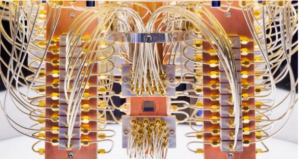
NVIDIA is working with leaders in quantum computing to build the tools for quantum developer, the team announced in a blog post.
Today’s high-performance computers are simulating quantum computing jobs at scale and with performance far beyond what’s possible on today’s smaller and error-prone quantum systems,” wrote Timothy Costa, group project manager for HPC and Quantum at NVIDIA. “In this way, classical HPC systems are helping quantum researchers chart the
right path forward.”
The vision is a hybrid computing model where quantum and classical computers work
together to address the challenges they are best at solving. According to Costa, the systems will need a unified programming environment that’s efficient and easy to use.
“We’re building this onramp to the future of computing today,” Costa writes. “Starting
with commercially available tools, like NVIDIA cuQuantum, we’re collaborating with IBM, Oak Ridge National Laboratory, Pasqal and many others.”

NVIDIA is first developing a new quantum compiler, called nvq++, which will target the Quantum Intermediate Representation (QIR), a specification of a low-level machine language that quantum and classical computers can use to talk to each other.
Researchers at Oak Ridge National Laboratory, Quantinuum, Quantum Circuits Inc., and others have embraced the QIR Alliance, led by the Linux Foundation. It enables an agnostic programming approach that will deliver the best from both quantum and classical computers.
NVIDIA is also collaborating with IBM to develop an open-source quantum simulation backend using QIR and researchers at the Oak Ridge National Laboratory will be among the first to use this new software.
“Accelerating quantum workflows represents a critical part of the future of high performance computing. However, efficiently simulating general dynamic quantum circuits can present a barrier,” said Aparna Prabhakar, Vice President, Partner Ecosystems, IBM Quantum. “We look forward to addressing this challenge with a tool chain based on QIR and platforms like NVIDIA cuQuantum.”
NVIDIA cuQuantum, which runs complex quantum circuit simulations with libraries for tensor networks and state vectors, is now in general release. cuQuantum DGX Appliance, a container with all the components needed to run cuQuantum jobs optimized for NVIDIA DGX A100 systems, is available in beta release.
If you found this article to be informative, you can explore more current quantum news here, exclusives, interviews, and podcasts.
















